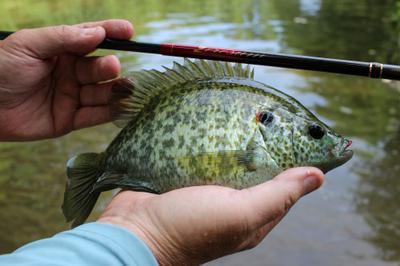Quality Tenkara Rods
by John Evans
(San Antonio, TX)

Nissin Zerosum 360 Easily Handled this Hefty Shellcracker
Quality Tenkara Rods
When a person tries tenkara fishing, one of the first things he notices is the wide price ranges of the rods. You can buy a rod that at least claims to be built for tenkara fishing for less than ten bucks on some websites. You can also spend a couple of hundred dollars for a different rod that claims to do the same thing. What gives? Are there any real differences, and, if so, is a more expensive rod worth the extra money?
There’s the old saying that you “get what you pay for.” A friend told me one time that he likes to change that to “You SHOULD get what you pay for”. My wife and I have been tenkara fishing for about three years now, under a variety of circumstances, and we’ve owned over 20 rods. We’ve also broken 3 of those rods under normal conditions—that is, we were using the correct tippet, pursuing the right kind of fish, not abusing the rod, and didn’t suffer accidents. All three rods that we broke were less expensive “Brand X” rods, and none of them were the higher-quality Japanese rods, such as the ones that Chris Stewart carries on TenkaraBum. I’m sure other people have more experience than we do, but what have we learned about the quality and usefulness of tenkara rods during that time?
It all comes down to workmanship and components. Yes, there are exceptions to what I’m about to say, but our fishing has taught us that rods made by, or for, Japanese companies tend to be better than other rods. Is there a thing wrong with a beginning tenkara angler buying a medium-priced “Brand X” rod to see if he enjoys the sport first? Of course not! I have a couple of poles just like that and still enjoy them a great deal.
But, from what I can tell, the carbon fiber blanks are simply lighter, stronger, and better on many of the Japanese rods, plus the tolerances on the telescoping joints and lillian tip are superior. Nice fit and finish add to the enjoyment of these rods, and you are not as likely to find sloppy manufacturing/quality-control issues. They are smoother, better balanced, and more pleasing to the touch than the less-expensive poles.
Once a person gains a little experience, these differences in quality become more noticeable. Why is there so much cork filler on that one rod? Why is the lillian joint already coming apart after a half dozen uses? Why doesn’t this pole collapse and extend smoothly, even after I’ve cleaned each section?
Yes, you can easily break ANY tenkara rod through abuse, neglect, or accident. But, if you use the rod for what it was intended, allowing it to bend along its entire length (not grabbing it in the middle for a big fish! Not using the tip to jerk a fly out of a tree!), the premium rod often ends up being cheaper and more enjoyable in the long run.
I respect that anglers must purchase the tackle that fits their budgets, but in my experience it would be better to have one or two nice tenkara rods instead of ten so-so ones. Wouldn’t it be better to save up and get a rod that’s going to do what you need it to do, and do it for a long time, than to rush out and buy a cheaper pole that reminds you of its inferior design and materials every time you cast?
Return to Your Tenkara Stories.
“The bitterness of poor quality remains long after the sweetness of low price is forgotten” - Benjamin Franklin
"Be sure in casting, that your fly fall first into the water, for if the line fall first, it scares or frightens the fish..." -
Col. Robert Venables 1662
As age slows my pace, I will become more like the heron.
Warning:
The hooks are sharp.
The coffee's hot.
The fish are slippery when wet.
Beware of the Dogma
Currently processing orders that were received Mar 8.


